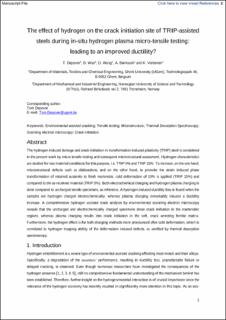| dc.contributor.author | Depover, Tom | |
| dc.contributor.author | Wan, Di | |
| dc.contributor.author | Wang, Dong | |
| dc.contributor.author | Barnoush, Afrooz | |
| dc.contributor.author | Verbeken, Kim | |
| dc.date.accessioned | 2020-09-07T08:12:51Z | |
| dc.date.available | 2020-09-07T08:12:51Z | |
| dc.date.created | 2020-07-17T13:10:07Z | |
| dc.date.issued | 2020 | |
| dc.identifier.issn | 1044-5803 | |
| dc.identifier.uri | https://hdl.handle.net/11250/2676555 | |
| dc.description.abstract | The hydrogen induced damage and crack initiation in transformation induced plasticity (TRIP) steel is considered in the present work by micro tensile testing and subsequent microstructural assessment. Hydrogen characteristics are studied for two material conditions for this purpose, i.e. TRIP 0% and TRIP 15%. To increase, on the one hand, microstructural defects such as dislocations, and on the other hand, to provoke the strain induced phase transformation of retained austenite to fresh martensite, cold deformation of 15% is applied (TRIP 15%) and compared to the as-received material (TRIP 0%). Both electrochemical charging and hydrogen plasma charging is done compared to uncharged tensile specimens, as reference. A hydrogen induced ductility loss is found when the samples are hydrogen charged electrochemically, whereas plasma charging remarkably induces a ductility increase. A comprehensive hydrogen assisted crack analysis by environmental scanning electron microscopy reveals that the uncharged and electrochemically charged specimens show crack initiation in the martensitic regions, whereas plasma charging results into crack initiation in the soft, crack arresting ferritic matrix. Furthermore, the hydrogen effect is for both charging methods more pronounced after cold deformation, which is correlated to hydrogen trapping ability of the deformation induced defects, as verified by thermal desorption spectroscopy. | en_US |
| dc.language.iso | eng | en_US |
| dc.publisher | Elsevier | en_US |
| dc.rights | Attribution-NonCommercial-NoDerivatives 4.0 Internasjonal | * |
| dc.rights.uri | http://creativecommons.org/licenses/by-nc-nd/4.0/deed.no | * |
| dc.title | The effect of hydrogen on the crack initiation site of TRIP-assisted steels during in-situ hydrogen plasma micro-tensile testing: Leading to an improved ductility? | en_US |
| dc.type | Peer reviewed | en_US |
| dc.type | Journal article | en_US |
| dc.description.version | acceptedVersion | en_US |
| dc.source.volume | 167 | en_US |
| dc.source.journal | Materials Characterization | en_US |
| dc.identifier.doi | 10.1016/j.matchar.2020.110493 | |
| dc.identifier.cristin | 1819715 | |
| dc.relation.project | Norges forskningsråd: 244068/E30 | en_US |
| dc.description.localcode | © 2020. This is the authors’ accepted and refereed manuscript to the article. Locked until 8.7.2022 due to copyright restrictions. This manuscript version is made available under the CC-BY-NC-ND 4.0 license http://creativecommons.org/licenses/by-nc-nd/4.0/ " | en_US |
| cristin.ispublished | true | |
| cristin.fulltext | postprint | |
| cristin.qualitycode | 1 | |

